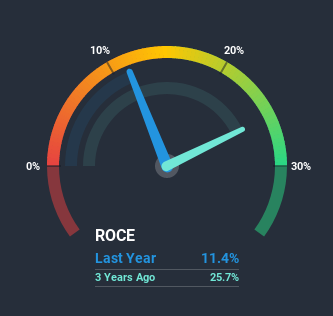What Do The Returns On Capital At Big Lots (NYSE:BIG) Tell Us?
What are the early trends we should look for to identify a stock that could multiply in value over the long term? Firstly, we'll want to see a proven return on capital employed (ROCE) that is increasing, and secondly, an expanding base of capital employed. Put simply, these types of businesses are compounding machines, meaning they are continually reinvesting their earnings at ever-higher rates of return. Having said that, from a first glance at Big Lots (NYSE:BIG) we aren't jumping out of our chairs at how returns are trending, but let's have a deeper look.
What is Return On Capital Employed (ROCE)?
For those that aren't sure what ROCE is, it measures the amount of pre-tax profits a company can generate from the capital employed in its business. The formula for this calculation on Big Lots is:
Return on Capital Employed = Earnings Before Interest and Tax (EBIT) ÷ (Total Assets - Current Liabilities)
0.11 = US$348m ÷ (US$4.2b - US$1.2b) (Based on the trailing twelve months to October 2020).
Therefore, Big Lots has an ROCE of 11%. In absolute terms, that's a pretty standard return but compared to the Multiline Retail industry average it falls behind.
View our latest analysis for Big Lots
In the above chart we have measured Big Lots' prior ROCE against its prior performance, but the future is arguably more important. If you're interested, you can view the analysts predictions in our free report on analyst forecasts for the company.
So How Is Big Lots' ROCE Trending?
On the surface, the trend of ROCE at Big Lots doesn't inspire confidence. Over the last five years, returns on capital have decreased to 11% from 21% five years ago. Although, given both revenue and the amount of assets employed in the business have increased, it could suggest the company is investing in growth, and the extra capital has led to a short-term reduction in ROCE. If these investments prove successful, this can bode very well for long term stock performance.
On a side note, Big Lots has done well to pay down its current liabilities to 27% of total assets. So we could link some of this to the decrease in ROCE. Effectively this means their suppliers or short-term creditors are funding less of the business, which reduces some elements of risk. Since the business is basically funding more of its operations with it's own money, you could argue this has made the business less efficient at generating ROCE.
The Bottom Line On Big Lots' ROCE
In summary, despite lower returns in the short term, we're encouraged to see that Big Lots is reinvesting for growth and has higher sales as a result. These trends are starting to be recognized by investors since the stock has delivered a 35% gain to shareholders who've held over the last five years. So this stock may still be an appealing investment opportunity, if other fundamentals prove to be sound.
Big Lots does come with some risks though, we found 4 warning signs in our investment analysis, and 2 of those are significant...
For those who like to invest in solid companies, check out this free list of companies with solid balance sheets and high returns on equity.
This article by Simply Wall St is general in nature. It does not constitute a recommendation to buy or sell any stock, and does not take account of your objectives, or your financial situation. We aim to bring you long-term focused analysis driven by fundamental data. Note that our analysis may not factor in the latest price-sensitive company announcements or qualitative material. Simply Wall St has no position in any stocks mentioned.
Have feedback on this article? Concerned about the content? Get in touch with us directly. Alternatively, email editorial-team (at) simplywallst.com.

